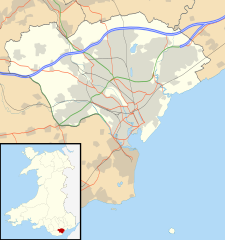
Cardiff is the capital and largest city of Wales. Cardiff had a population of 362,310 in 2021 and forms a principal area officially known as the City and County of Cardiff. The city is the eleventh largest in the United Kingdom. Located in the southeast of Wales and in the Cardiff Capital Region, Cardiff is the county town of the historic county of Glamorgan and in 1974–1996 of South Glamorgan. It belongs to the Eurocities network of the largest European cities. A small town until the early 19th century, its prominence as a port for coal when mining began in the region helped its expansion. In 1905, it was ranked as a city and in 1955 proclaimed capital of Wales. Cardiff Built-up Area covers a larger area outside the county boundary, including the towns of Dinas Powys and Penarth.

The Vale of Glamorgan, locally referred to as The Vale, is a county borough in the south-east of Wales. It borders Bridgend County Borough to the west, Cardiff to the east, Rhondda Cynon Taf to the north, and the Bristol Channel to the south. With an economy based largely on agriculture and chemicals, it is the southernmost unitary authority in Wales. Attractions include Barry Island Pleasure Park, the Barry Tourist Railway, Medieval wall paintings in St Cadoc's Church, Llancarfan, Porthkerry Park, St Donat's Castle, Cosmeston Lakes Country Park and Cosmeston Medieval Village. The largest town is Barry. Other towns include Penarth, Llantwit Major, and Cowbridge. There are many villages in the county borough.

Penarth is a town and community in the Vale of Glamorgan, Wales, approximately 3 miles (4.8 km) south of Cardiff city centre on the west shore of the Severn Estuary at the southern end of Cardiff Bay.

The River Taff is a river in Wales. It rises as two rivers in the Brecon Beacons; the Taf Fechan and the Taf Fawr before becoming one just north of Merthyr Tydfil. Its confluence with the River Severn estuary is in Cardiff.

University Hospital of Wales (UHW), also known as the Heath Hospital, is a 1,080-bed hospital in the Heath district of Cardiff, Wales. It is a teaching hospital of Cardiff University School of Medicine. Construction started in 1963, and the official opening took place in 1971. It was Europe's first fully integrated hospital and medical school, at a cost of £22 million. It is the third largest university hospital in the UK, and the largest hospital in Wales. The hospital was previously managed by Cardiff & Vale NHS Trust. In 2009 the Trust was dissolved and the hospital is now managed by Cardiff and Vale University Health Board.

Grangetown is a district and community in the south of Cardiff, capital of Wales. It is one of the largest districts in the south of the city and is bordered by Riverside, Canton and Butetown. The River Taff winds its way through the area. Adjacent to the city's Cardiff Bay area, Grangetown is experiencing a period of gentrification and improvements in its infrastructure. Its population as of 2011 was 19,385 in 8,261 households. One of the "five towns of Cardiff", the others are Butetown, Crockherbtown, Newtown and Temperance Town.

Cefn Mably House is a mansion situated in Cefn Mably, Caerphilly County Borough, Wales. It is a Grade II listed building. The gardens surrounding the house are listed on the Cadw/ICOMOS Register of Parks and Gardens of Special Historic Interest in Wales.
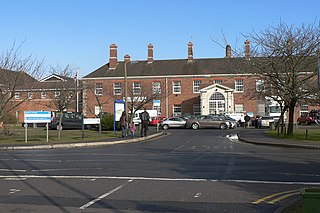
Llandough is a village, community and electoral ward in the Vale of Glamorgan, Wales, approximately 2.3 miles (3.7 km) south west of Cardiff city centre, and approximately 1.3 miles (2 km) north west of Penarth.

Dyffryn Gardens, also spelt Duffryn Gardens, is a collection of botanical gardens located near the villages of Dyffryn and St. Nicholas in the Vale of Glamorgan, Wales. The gardens were selected by the British Tourist Authority as one of the Top 100 gardens in the UK and are in the care of the National Trust. They are designated at Grade I, the highest grade, on the Cadw/ICOMOS Register of Parks and Gardens of Special Historic Interest in Wales.

Cardiff and Vale University Health Board is the local health board of NHS Wales for Cardiff and Vale of Glamorgan, in the south-east of Wales. Formed on 1 October 2009 through the amalgamation of three NHS organisations in the Cardiff and Vale of Glamorgan area. The three organisations amalgamated were: Cardiff and Vale NHS Trust, employing 12,000 staff and previously responsibility for hospital services in the Cardiff and Vale of Glamorgan area; Cardiff Local Health Board; and Vale of Glamorgan Local Health Board both responsible for GP, Dental, Optical and pharmacy services. The headquarters of the Board is in the University Hospital of Wales, in Cardiff. Cardiff and Vale University Health Board is the operational name of Cardiff and Vale Local Health Board.

Whitchurch Hospital was a psychiatric hospital in Whitchurch, an area in the north of Cardiff. It was managed by the Cardiff and Vale University Health Board. The hospital remains a grade II listed building. Its grounds are separately listed, also at Grade II, on the Cadw/ICOMOS Register of Parks and Gardens of Special Historic Interest in Wales.

Michaelston-le-Pit is a village in the Vale of Glamorgan, just to the west of the city of Cardiff, Wales. It is part of the Michaelston-le-Pit and Leckwith community. The community population taken at the 2011 census was 309.
The Artificial Limb & Appliance Service (ALAS) is an NHS Wales organisation providing support, equipment and rehabilitation to people with permanent or long-term impairment. It is commissioned by Health Commission Wales, and is provided through a consortium arrangement between three NHS Wales trusts, each hosting one centre (ALAC). The centres are situated in:
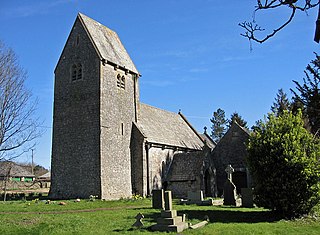
St Lythans is an affluent hamlet and former parish in the Vale of Glamorgan, southeast Wales, just outside western Cardiff. It lies southwest of Culverhouse Cross, west of Wenvoe and southwest of Twyn-yr-Odyn and is also connected by road from Dyffryn and the Five Mile Lane in the west. It is one of the wealthiest communities in the Vale of Glamorgan, containing some notable mansions and cottages, valued on average at over £500,000 as of 2011. The megalithic St Lythans burial chamber, over 6000 years old, lies 1 km to the west of the village and the hamlet also contains the St.Lythans Parish Church or Church of St Bleddian, a Grade II* listed building.
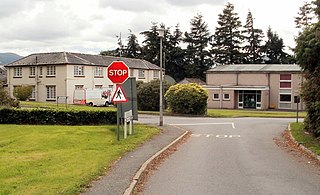
Bronllys Hospital is a heath facility in Bronllys, Wales. It is managed by Powys Teaching Health Board. The Basil Webb Hall and the Chapel are Grade II listed buildings. The hospital grounds are listed Grade II on the Cadw/ICOMOS Register of Parks and Gardens of Special Historic Interest in Wales.

University Hospital Llandough is a district general hospital in Llandough, Penarth, Wales. It is managed by the Cardiff and Vale University Health Board.
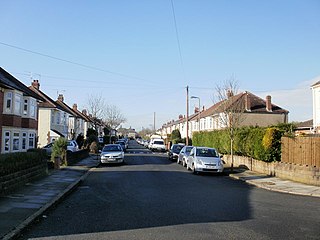
Thomas Alwyn Lloyd OBE, known as T. Alwyn Lloyd, was a Welsh architect and town planner. He was one of the founders of the Town Planning Institute in 1914 and its President in 1933. He was also a founding member of the Council for the Protection of Rural Wales in 1928 and served as its chairman from 1947 to 1959. Meic Stephens described Lloyd's work as follows:
Lloyd's small-scale buildings reflected his deep feeling for place, in both historical and environmental terms, as in the Garden Villages for which he was responsible in various parts of Wales.

Dragon's Heart Hospital was a temporary hospital located at the Millennium Stadium in Cardiff. It opened on 13 April 2020 to help deal with the impact of the COVID-19 pandemic in Wales. It was decommissioned towards the end of October and early November 2020.

The City and County of Cardiff is a county in the south of Wales. It covers an area of 140.3 km2 (54.2 sq mi) and in 2023 the population was approximately 359,512. Cardiff is the country's capital and hosts its parliament, the Senedd, and a large number of national institutions such as the Wales Millennium Centre, the National Museum, the national stadium of Wales and the St Fagans National Museum of History.

